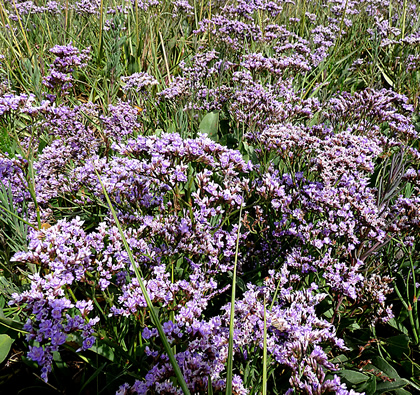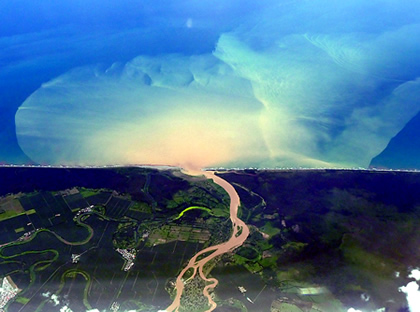 |
| Kilchis Estuary, Oregon |
Estuaries are the areas where rivers run into oceans. They often exist where the opening to the sea is somehow obstructed, for example by a sandbar or a lagoon (sandbars are ridges of sand built up by water; lagoons are shallow areas of water separated from the ocean by sandbars or coral). The water in estuaries is dominated by the flow of the tides.
When tides are high, the ocean water washes through the estuary bringing with it sediments (particles of sand, silt, and gravel), nutrients, and organisms from the ocean. When the tide is low, the freshwater of the river floods the area, releasing its load into the estuary.
Because estuaries exist where two different types of water come together and where the land meets the water, estuaries provide many different types of habitats for animals and plants. In addition, both the river and the ocean bring estuaries nutrients such as nitrate and phosphate, which plants need to grow.
  |
This results in a complex range of plants and animals that thrive there. Estuaries are also important to human settlement and economics. As a result, estuaries are often subject to pollution and other environmental stresses.
General Structure of an Estuary
The part of the estuary farthest from the ocean is often called a salt marsh. (A marsh is a wetland dominated by grasses.) Water usually flows through salt marshes in tidal creeks.
Unlike river water, the water in tidal creeks can flow in two directions. When the tide comes in, the water runs into the salt marsh and when the tide goes out, the water runs the opposite direction, away from the salt marsh.
 |
| Salt marsh in James Island, South Carolina |
The part of an estuary closer to the ocean may contain mudflats (a thick, flat layer of mud or sand that is usually underwater at high tide) and sandbars. These areas are exposed when the tide is out and may be covered with water when the tide is in.
They are often covered with a layer of thin algae, which are tiny rootless plants that grow in sunlit water. Many different types of burrowing (digging holes or tunnels) creatures, like clams and worms, live on mudflats and sandbars. Birds often walk along mudflats and sandbars when the tide is out, hunting for prey (animals hunted for food) buried in the ground.
The ocean edge of the estuary is almost always covered with water, although its depth changes with the tides. In this region, river water and ocean water mix and the resulting water has a salinity (the concentration of salt in water) that is neither fresh nor seawater.
This type of water is called brackish. Brackish water includes water of a large range of salinities, from freshwater, which is about 0.5 part salt per thousand parts of water (ppt) to seawater, which is about 35 ppt.
 |
| mudflats |
The ways that the freshwater and the ocean water mix within the estuary is often very complicated. Sometimes the freshwater sits on top of the ocean water, because it is less dense. When this occurs, a halocline forms between the two types of water. (The root word halo means “salt” and the root word cline means “change.”)
A halocline is a layer of water where the salinity changes very quickly. The halocline can act as a physical barrier between the freshwater on top and the saline water below, blocking the exchange of nutrients, and even organisms, between them.
Life in estuaries
Brackish waters pose one of the most important challenges for many animals and plants living in estuaries. Because the salinity of the water is constantly changing, their cells must be able to handle osmotic changes.
Osmosis is the tendency of water to have the same concentration on both sides of a material that allows liquid to pass (like a cell membrane, the structure surrounding a cell). When exposed to fresher water, cells that have grown accustomed to waters that are more saline will take in water, expand and even burst.
When exposed to more saline conditions, cells that have grown accustomed to fresher water will release water, shrivel, and perhaps die. There are a variety of animals and plants that have special adaptations so that they can live in waters with changing salinities and these organisms thrive in estuaries.
A second problem facing organisms that live in estuaries is the ever-changing water level. Because the tide goes in and out, animals and plants must be able to handle waterlogged environments as well as environments that are dry. Many animals burrow in the sand and mud in estuaries.
For example, sea cucumbers and polychaete worms live in holes in the mud. They expose their tentacles to the water where they capture plankton (free-floating organisms) and small prey that float into their reach. When the tide goes out, they burrow into their holes where they can stay moist.
Plant life in estuaries
The salt marsh region of the estuary is characterized by plants that are adapted to salty conditions. The high salt marsh cordgrass has special organs on its leaves that remove the salt it takes up from its roots.
The eelgrass, Spartina, looks like a grass with very tough leaves and stems that help it retain moisture in saltwater. It can be found in salt marshes throughout the East Coast of the United States. Other common salt marsh plants are sea-lavender, scurvy grass, salt marsh grass and sea-aster.
 |
| sea-lavender |
Farther out in the deeper waters of the estuary, microscopic phytoplankton (tiny plants that float in fresh or saltwater) are some of the most important plants.
These single-celled algaetype plants float near the surface of the water where sunlight is available. Because the ocean water and the river water both deposit the nutrients that phytoplankton needs to grow quickly, phytoplankton in estuaries flourish.
The large populations of phytoplankton are food for zooplankton (free-floating animals, often microscopic). In turn, the phytoplankton and zooplankton are meals for worms, clams, scallops, oysters and crustaceans (aquatic animals with jointed limbs and a hard shell).
Animal life in estuaries
Because the types of habitats in estuaries are so diverse, estuaries are home to many different species of animals. Worms, clams, oysters, sea cucumbers, sea anemones and crabs all make their homes in the muddy floor of the estuary. Many of them burrow in the mud and filter the water for plankton and small fish that swim within the grasp of their tentacles and claws.
In some places, the clams and oysters become so numerous that their shells provide special habitats for other small animals. Barnacles grow on oyster shells in oyster beds.
Small fish, snails, and crabs will hide from larger predators in the crevasses between clamshells. Mosses and algae will grow on the surfaces of some molluscs, providing food for the animals that take refuge there.
A variety of fish live in estuaries. Very small fish called gobies hunt along muddy and rocky surfaces for small crustaceans like shrimp.
Long slender fish called pipefish swim among the grasses in the marsh, their shape blending in with the long blades of the plants. Larger fish like halibut and flounder, swim along the muddy floor, their flattened shape allowing them to move into the shallow regions of the estuary.
Large predatory fish like redfish, snook, striped bass, mullet, jack, and grouper make their way into estuaries to feed on the rich supply of fish that can be found. Salmon pass through estuaries on their way up rivers to breed.
Many fish and invertebrates (animals without a backbone) use the estuary as a nursery ground for their young. For example, in Florida, a variety of species of shrimp spawn in the ocean, and their larvae (immature young) travel to the mouth of the estuary, where they develop into young shrimp.
At a certain stage of their development, they ride the tide into the estuary, where they live among the eelgrass. The eelgrass provides them with protection from predators and the rich nutrients in the estuary produce plenty of food for them to eat. Once the shrimp become adults, they swim back to the ocean, where they spawn, producing young that will move back to the estuaries again.
Birds are extremely numerous in estuaries. During low tides, a variety of shorebirds walk along mudflats, pecking their beaks into holes where worms, crabs and clams are buried. Herons scour the shallow waters for shrimp and small fish. Brown pelicans, an endangered species, use estuaries as breeding grounds and nesting areas for their young.
Importance of estuaries
Estuaries are a unique habitat for a large variety of animals and plants. Because of their complexity a broad variety of species live in estuaries, either for part of their lives or for their entire life.
The U.S. Department of Fisheries estimates that three-quarters of the fish and shellfish that people eat depend on estuaries at some point during their lives. Oysters, clams, flounder, and striped bass may live their entire lives within estuaries.
Estuaries serve as a buffer from flooding and storm surges. The soil and mud in estuaries is absorbent and can absorb large quantities of water. In addition, the roots of the grasses and sedges (grass-like plants) in estuaries are able to hold together sediments and protect against erosion (wearing away of land). Estuaries provide important protection to the real estate in many coastal communities.
As water moves through an estuary it is naturally filtered and cleaned. The many plants and bacteria that live in the estuary use pollutants, like agricultural fertilizers, to grow. Sediments that are transported to estuaries by rivers tend to settle into the estuary, where they act as filters, allowing cleaner water to flow into the ocean.
Danger to estuaries
Bacteria can break down some, but not all pollutants and many pollutants are not taken in by plants. Pollutants can build up to harmful concentrations within estuaries that threaten the health of the birds, fish, and humans that live nearby.
There are four major types of environmental stresses that affect Chesapeake Bay, the largest estuary in the United States. The most damaging type of pollution to the Bay is the input of nutrients like phosphate and nitrate, which are fertilizers used in agriculture.
High concentrations of nutrients enter the Bay as rainwater runoff from land and from sewage treatment facilities. Although they are required for plants to grow, high concentrations can cause overgrowth of algae and marsh plants. This overgrowth can result in the plants using up all the oxygen in the water, causing the fish to die.
 |
| the input of sediments |
A second type of pollution is the input of sediments like clay, sand, and gravel that enter the Bay through river runoff. Although sedimentation is a natural occurrence, increased rates of erosion sometimes cause large amounts of sediments to be deposited in the Bay. Sediments can clog the feeding apparatus of filter-feeding animals and can cloud the water making it more difficult for plants to get light.
Air pollution is a third source of stress on the bay. Pollutants released from factories and cars as exhaust eventually make their way to the bay. Some of these pollutants produce acid rain, which changes the acidity of the bay, while others contribute to the concentration of nitrogen in the bay.
Although evidence shows that dangerous pollutants, a fourth stress on the environment of the bay, are currently not as damaging as the other forms of pollution, the release of chemicals into the bay from some of the industries in the region can be deadly to both animals and plants.